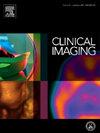Radiomics and machine learning models for diagnosing microvascular invasion in cholangiocarcinoma: a systematic review and meta-analysis of diagnostic test accuracy studies
IF 1.8
4区 医学
Q3 RADIOLOGY, NUCLEAR MEDICINE & MEDICAL IMAGING
引用次数: 0
Abstract
Purpose
We aimed to systematically assess the value of radiomics/machine learning (ML) models for diagnosing microvascular invasion (MVI) in patients with cholangiocarcinoma (CCA) using various radiologic modalities.
Methods
A systematic search of was conducted on Web of Sciences, PubMed, Scopus, and Embase. All the studies that assessed the value of radiomics models or ML models along with the use of imaging features were included. The Quality Assessment of Diagnostic Accuracy Studies (QUADAS-2) criteria and METhodological RadiomICs Score (METRICS) were used for quality assessment. Pooled estimates for the diagnostic performance of radiomics/ML models were calculated. I-squared was used to assess heterogeneity, and sensitivity and subgroup analyses were performed to find the sources of heterogeneity. Deeks' funnel plots were used to assess publication bias.
Results
11 studies were included in the systematic review with only one study being about extrahepatic CCA. According to the METRICS, the mean score was 62.99 %. Meta-analyses were performed on intrahepatic CCA studies. The meta-analysis of the best ML models revealed an AUC of 0.93 in the training cohort and an AUC of 0.85 in the validation cohort. Regarding the best radiomics model, the AUC was 0.85 in the training cohort and 0.81 in the validation cohort.
Conclusion
Radiomics/ML models showed very good diagnostic performance regarding MVI diagnosis in patients with intrahepatic CCA and may provide a non-invasive method for this purpose. However, given the high heterogeneity and low number of the included studies, further multi-center studies with prospective design and robust external validation are essential.
求助全文
约1分钟内获得全文
求助全文
来源期刊

Clinical Imaging
医学-核医学
CiteScore
4.60
自引率
0.00%
发文量
265
审稿时长
35 days
期刊介绍:
The mission of Clinical Imaging is to publish, in a timely manner, the very best radiology research from the United States and around the world with special attention to the impact of medical imaging on patient care. The journal''s publications cover all imaging modalities, radiology issues related to patients, policy and practice improvements, and clinically-oriented imaging physics and informatics. The journal is a valuable resource for practicing radiologists, radiologists-in-training and other clinicians with an interest in imaging. Papers are carefully peer-reviewed and selected by our experienced subject editors who are leading experts spanning the range of imaging sub-specialties, which include:
-Body Imaging-
Breast Imaging-
Cardiothoracic Imaging-
Imaging Physics and Informatics-
Molecular Imaging and Nuclear Medicine-
Musculoskeletal and Emergency Imaging-
Neuroradiology-
Practice, Policy & Education-
Pediatric Imaging-
Vascular and Interventional Radiology
 求助内容:
求助内容: 应助结果提醒方式:
应助结果提醒方式:


